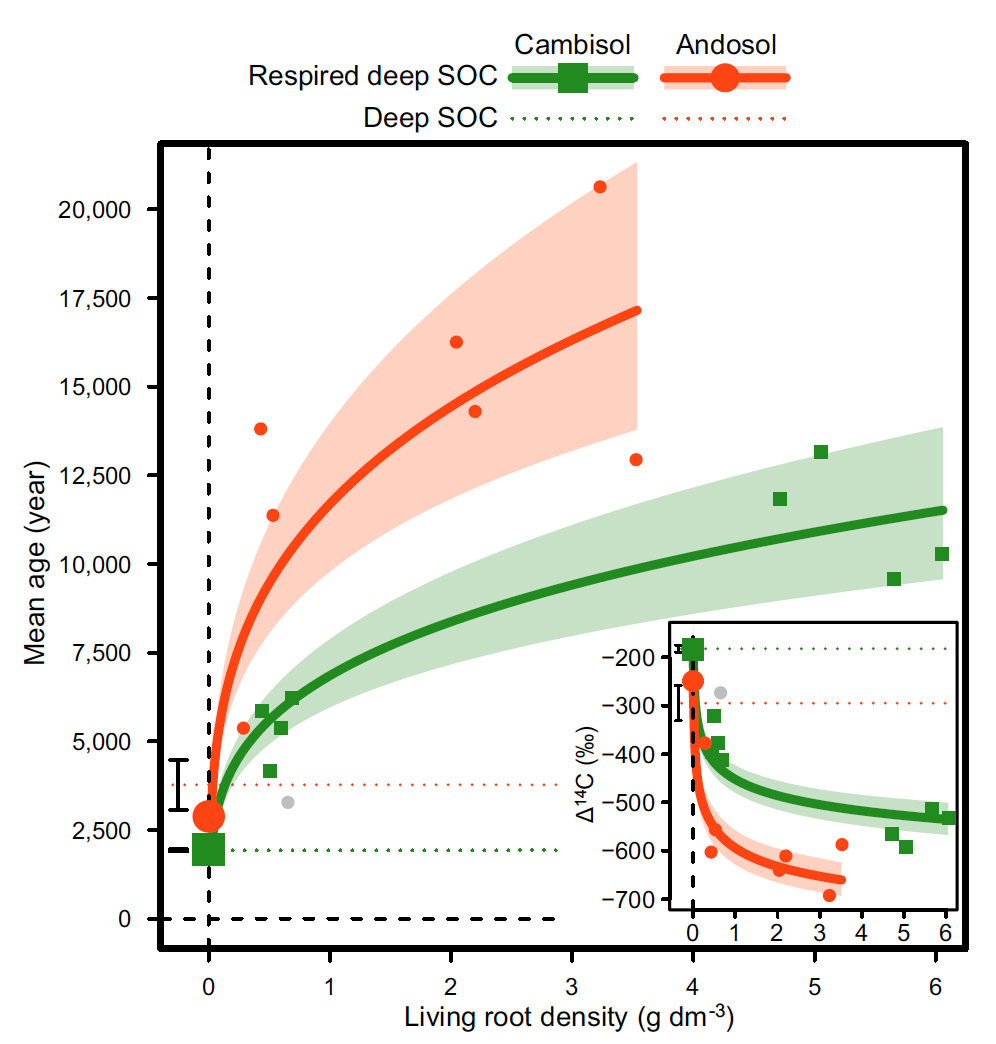Bioenergetic control of soil carbon dynamics across depth
Soil carbon dynamics is strongly controlled by depth globally, with increasingly slow dynamics found at depth. The mechanistic basis remains however controversial, limiting our ability to predict carbon cycle-climate feedbacks. Here we combine radiocarbon and thermal analyses with long-term incubations in absence/presence of continuously 13C/14C-labelled plants to show that bioenergetic constraints of decomposers consistently drive the depth-dependency of soil carbon dynamics over a range of mineral reactivity contexts. The slow dynamics of subsoil carbon is tightly related to both its low energy density and high activation energy of decomposition, leading to an unfavourable ‘return-on-energy-investment’ for decomposers. We also observe strong acceleration of millennia-old subsoil carbon decomposition induced by roots (‘rhizosphere priming’), showing that sufficient supply of energy by roots is able to alleviate the strong energy limitation of decomposition. These findings demonstrate that subsoil carbon persistence results from its poor energy quality together with the lack of energy supply by roots due to their low density at depth.

Figure 1: Root effects on the mean age of subsoil organic carbon respired by decomposers. Response of radiocarbon-based mean age of respired CO2 derived from the decomposition of native deep soil organic carbon (SOC) to the variation in living root density across soil column depth at the soil core scale in the second incubation series 279 days after planting (n = 24 soil core incubations). The inset show radiocarbon signatures (Δ14C) of soil-respired CO2 used to determine the mean age of respired native SOC. Since turnover time and mean age are identical under our model assumption of SOC being a homogeneous one-pool reservoir at steady-state, the mean ages were estimated using the same modelling approach used for turnover time as described in the methods section. Symbols with error bars along the vertical dashed line show treatment means ± standard errors of unplanted controls (n = 4 soil core incubations). Horizontal dotted lines with error bars show the means ± standard errors of mean ages (turnover times) and radiocarbon signatures of initial deep SOC. Polygons around regression lines represent 95% confidence intervals
Reference : Hénneron L., Balesdent J., Alvarez J., Barré P., Baudin F., Basile-Doelsch I., Cécillon L., Fernandez-Martinez A., Hatté C., Fontaine S., 2022. Bioenergetic control of soil carbon dynamics across depth. Nature Communications 13, 7676. doi: 10.1038/s41467-022-34951-w
Le projet d'équipement EXTRAAAAAA est retenu pour financement par le DIM PAMIR
Le comité de pilotage du DIM PAMIR (Domaine de Recherche et d'Innovation Majeur - Patrimoines matériels – innovation, expérimentation, résilience) a voté, au titre de l'Appel à Projets 2023 au fil de l'eau, le financement de projet d'équipement EXTRAAAAAA : EXTRAction AutomAtisée et Améliorée de biomArqueurs moléculAires.
 EXTRAAAAAA vise l’acquisition d’un équipement permettant l’extraction automatisée, reproductible, efficace et rapide de biomarqueurs moléculaires des matrices géologiques, archéologiques et biologiques dans lesquels ils sont préservés. Cet équipement facilitera et fiabilisera la préparation d’échantillons en amont du plateau technique d’analyses des biomarqueurs moléculaires du LSCE, intégré dans PANOPLY et RéGEF. Il sera ainsi possible d’accélérer la préparation de grandes séries d’échantillons et d’améliorer les rendements d’extraction afin de garantir des quantités suffisantes pour des analyses spécifiques (datation par radiocarbone de composés individuels, certification des structures par RMN).
EXTRAAAAAA vise l’acquisition d’un équipement permettant l’extraction automatisée, reproductible, efficace et rapide de biomarqueurs moléculaires des matrices géologiques, archéologiques et biologiques dans lesquels ils sont préservés. Cet équipement facilitera et fiabilisera la préparation d’échantillons en amont du plateau technique d’analyses des biomarqueurs moléculaires du LSCE, intégré dans PANOPLY et RéGEF. Il sera ainsi possible d’accélérer la préparation de grandes séries d’échantillons et d’améliorer les rendements d’extraction afin de garantir des quantités suffisantes pour des analyses spécifiques (datation par radiocarbone de composés individuels, certification des structures par RMN).
Lien vers la page du DIM PAMIR.
Crédit photo : ©Cyril Fresillon - ISTO - CNRS Photothèque


